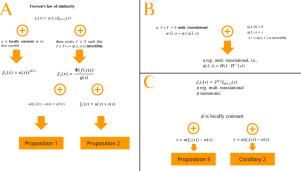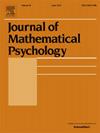On Iverson’s law of similarity
IF 1.5
4区 心理学
Q2 MATHEMATICS, INTERDISCIPLINARY APPLICATIONS
引用次数: 0
Abstract
Iverson (2006b) proposed the law of similarity for the sensitivity functions . Compared to the former models, the generality of this one lies in that here and can also depend on the variables and . In the literature, this model (or its special cases) is usually considered together with a given psychophysical representation (e.g. Fechnerian, subtractive, or affine). Our goal, however, is to study at first Iverson’s law of similarity on its own. We show that if certain mild assumptions are fulfilled, then can be written in a rather simple form containing only one-variable functions. The obtained form proves to be very useful when we assume some kind of representation.
Motivated by Hsu and Iverson (2016), we then study the above model assuming that the mapping is multiplicatively translational. First, we show how these mappings can be characterized. Later we turn to the examination of Falmagne’s power law. According to our results, the corresponding function can have a Fechnerian representation, and also it can have a subtractive representation. We close the paper with the study of the shift invariance property.

关于艾弗森的相似定律
Iverson (2006b)提出了灵敏度函数ξs(s∈s)的相似律ξs(λx)=γ(λ,s)ξη(λ,s)(x)。与之前的模型相比,这个模型的通用性在于,这里的γ和η也可以取决于变量λ和s。在文献中,这个模型(或它的特殊情况)通常与给定的心理物理表示(例如,费契纳式,减法式或仿射式)一起考虑。然而,我们的目标是首先研究艾弗森的相似性定律本身。我们证明,如果满足某些温和的假设,则ξ可以写成只包含单变量函数的相当简单的形式。当我们假设某种表示时,所得到的形式证明是非常有用的。在Hsu和Iverson(2016)的激励下,我们假设映射η是乘平移的,然后研究上述模型。首先,我们将展示如何对这些映射进行表征。稍后我们将讨论法尔曼幂定律。根据我们的结果,相应的函数ξ可以有一个法式表示,也可以有一个减法式表示。最后,我们研究了平移不变性。
本文章由计算机程序翻译,如有差异,请以英文原文为准。
求助全文
约1分钟内获得全文
求助全文
来源期刊

Journal of Mathematical Psychology
医学-数学跨学科应用
CiteScore
3.70
自引率
11.10%
发文量
37
审稿时长
20.2 weeks
期刊介绍:
The Journal of Mathematical Psychology includes articles, monographs and reviews, notes and commentaries, and book reviews in all areas of mathematical psychology. Empirical and theoretical contributions are equally welcome.
Areas of special interest include, but are not limited to, fundamental measurement and psychological process models, such as those based upon neural network or information processing concepts. A partial listing of substantive areas covered include sensation and perception, psychophysics, learning and memory, problem solving, judgment and decision-making, and motivation.
The Journal of Mathematical Psychology is affiliated with the Society for Mathematical Psychology.
Research Areas include:
• Models for sensation and perception, learning, memory and thinking
• Fundamental measurement and scaling
• Decision making
• Neural modeling and networks
• Psychophysics and signal detection
• Neuropsychological theories
• Psycholinguistics
• Motivational dynamics
• Animal behavior
• Psychometric theory
 求助内容:
求助内容: 应助结果提醒方式:
应助结果提醒方式:


